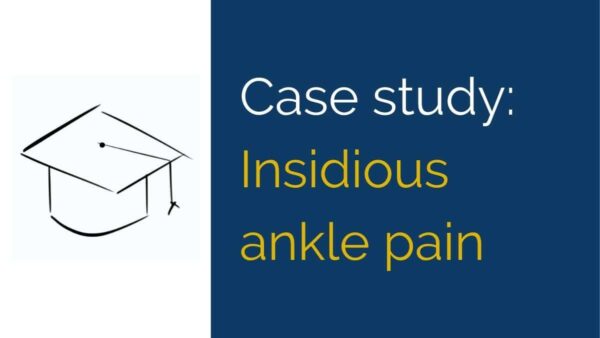Background – Ankle pain
This case study of an insidious onset anteromedial ankle pain is designed to challenge Physiotherapist’s ability to plan a structured approach to management in the absence of a clear mechanism of injury. The goal is to develop a provisional diagnosis, then structure the management plan to confirm this diagnosis.
Minimum level
New graduate Physiotherapist
History
Stephanie is a 21 year old university student with an active lifestyle. She currently plays representative level soccer and goes for a 5km run twice weekly on the same route.
She noticed a mild discomfort at the anteromedial aspect of the Right ankle after a run about four weeks ago. It only came on in the last 5 minutes of the usual run and disappeared soon after she stopped.
Stephanie couldn’t recall any incident in the weeks leading up to the onset of pain.
Based on this information alone, list 10 potential diagnoses that match the insidious and non-traumatic nature of this presentation, its location and the age of the patient.
She hadn’t injured the ankle this season but recalls an ankle sprain last season that put her out for 3 games, although she can’t recall which ankle was injured.
Name three of your original list which may be more likely given this recent history. Explain how each may predispose Stephanie to an insidious injury.
Stephanie’s footwear has not changed recently – her boots (Nike Tiempo Legend) are now 5 months old (new at the start of this season) and her runners (Saucony Kinvara 12) are around 8 months old.
Explain how this footwear may predispose Stephanie to 1-2 possible diagnoses.
Since the onset of her ankle pain 4 weeks ago, the symptoms begin earlier in a run – around 200-300m into her last run – and worsen over the course of the run.
During football training, Stephanie is only able to pass the ball with moderate power and is unable to kick or tackle with force as it causes considerable ankle pain. She has missed the last two games due to this injury.
Which of your original listed pathologies would be aggravated by both running and kicking a ball?
There doesn’t seem to be any obvious swelling in the area.
Does the lack of swelling assist in narrowing your diagnostic candidates?
After activity, the ankle now aches for the remainder of the day. It causes some ankle pain at night when lying on her back or stomach but eases in side lying.
There is mild pain in the morning on initial weightbearing but it eases within 10-15 minutes.
Does the aching after exercise help exclude any potential diagnosis/diagnoses?
Is the night pain a concern or red flag?
List and justify your top 3 diagnoses based on the information above.
Physical Examination
Stephanie stands with her weight evenly distributed and reports no pain in standing.
On a single leg squat, there is 6/10 pain in the anteromedial aspect of the Right ankle at 1/4 squat depth.
Does this finding exclude any of your diagnostic hypotheses?
On double leg squat, the pain is noticeable from half depth but is only 2/10 on a pain scale.
Explain how the difference between single and double leg squat findings impacts your diagnostic reasoning?
Aside from prioritising double leg squats, how might you use these findings in planning your rehab program?
Heel walking causes 4/10 ankle pain and has reduced dorsiflexion range on the Right.
What conclusions could you draw if passive dorsiflexion range was unaffected and greater than active range?
Toe walking and calf raises do not generate any ankle pain.
On palpation, there is pain at the anteromedial aspect of the joint where the joint line intersects with the Tibialis Anterior tendon.
Isometric muscle tests (IMT) are normal for power and do not cause ankle pain.
How does normal IMT findings fit with your diagnostic hypothesis?
What further testing would you perform at this stage? Limit your answer to only two tests and justify each selection.
Management plan
Given three possible diagnoses of Anteromedial Talocrural Impingement, Tibialis Anterior Tendinopathy and Talar Dome/Osteochondral injury, design your management plan to assist in confirming the diagnosis.
How would you expect these conditions to respond to each aspect of your plan?
Like to continue the conversation? Head over to our Facebook page.

